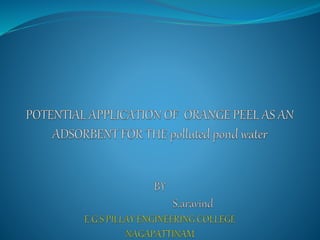Aravind
- 2. OBJECTIVE OF STUDY ïķ To examine the COD reduction in a selected polluted river wastewater by using natural adsorbents, to minimize the treatment cost. ïķTo removes the TSS present in the waste water. ïķTo check that it removes the color of trail sample.
- 3. LITERATURE REVIEW ïąIn our laboratory the work is in progress to demonstrate the management of solid textile mill sludge (STMS) by vermicomposting. ïąAline SartÃģrio Raymundo, Romina Zanarotto, Marciela BelisÃĄrio, Madson de GodoiPereira, Joselito Nardy Ribeiro and Araceli VerÃģnica Flores Nardy Ribeiro (2010) A methodology involving sugar cane bagasse bio-adsorbent was developed in order to remove the carcinogenic congo red dye from aqueous medium. ïąTeh Ubaidah Bt Noh (2010) Natural materials have been investigated as potential industrial adsorption media.
- 4. MATERIAL USED MATERIAL DEPTH SIZE USES Coarse Aggregate 20 cm 20mm Filter for waste water Fine aggregate 20 cm 4.75mm Filter for waste water Carbon 20 cm 2.75mm Remove dust Orange peel 20 cm 0.75mm Remove the color
- 7. SAMPLE COLLECTED âĒ The sample was collected from the Chandra river located at Karaikal district in Puducherry. âĒ The river was located near the Soap factory. Hence the chemical may contaminated into the river and polluted.
- 8. EXPRIMENTS ïpH Test, ïBOD Test, ïCOD Test, ïTURBIDITY Test, ïTOTAL SUSPENDED SOLIDS.
- 9. RESULT PARAMETER INFLUENT EFFLUENT STANDARD ODOUR Muddy smell None None COLOUR Bluish green 90% remove Colorless pH 8.67 7.9 8.5 TSS 2900 mg/l 495mg/l 500 - 5000 COD 1640 mg/l 265 mg/l 250 â 500 mg/l CONDUCTIVITY 10.9 milli-mho 2.3 milli-mho 5 milli-mho TURBIDITY 32.3 NTU 12.86 NTU 10 NTU
- 10. MERITS ï Eco-friendly. ï Materials are easily available. ï It removes acidic dyes from industrial effluent. ï Itâs a effective method for removing harmful wastes. ï Activated carbon obtained from orange peel via acid decomposition has been found to be an efficient material for dye removal. ï Low cost material for removing dyes effluent.
- 11. demerits ï We canât implement it for large scale. ï It takes much time to absorb the dyes. ï Maximum removal is up to 87% of wastes. ï Adsorption increases with increase in pH.
- 12. conclusion ïķ90% of colour has been removed from the water sample. ïķ80% of COD and TS has been removed from the water sample. ïķSo it is not suitable for drinking purpose but it will used to unobjectionable industrial uses such as cooling and non- potable domestically uses .
- 13. THANKING YOU












